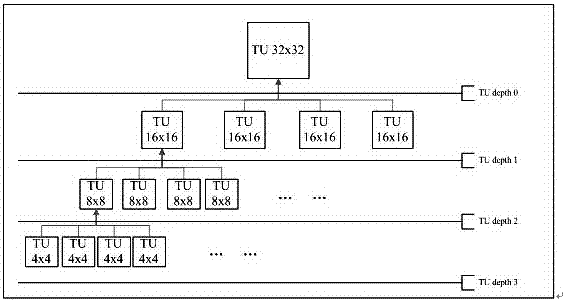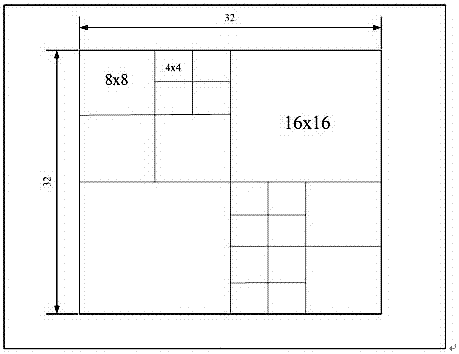TU tree structure decision algorithm based on HEVC video coding
A tree structure and video coding technology, applied in the field of video coding, can solve the problems of increased hardware cost, high computational complexity, and low hardware performance, and achieve the effect of reducing complexity, reducing complexity, and improving performance
- Summary
- Abstract
- Description
- Claims
- Application Information
AI Technical Summary
Problems solved by technology
Method used
Image
Examples
Embodiment
[0045] In HEVC video coding, the TU tree structure is a coding tool newly proposed by the HEVC video standard to improve coding efficiency. The TU sizes are 4x4, 8x8, 16x16, and 32x32. Blocks are used for rdcost (rate-distortion) calculations. TU blocks include 64 4x4 blocks, 16 8x8 blocks, 4 16x16 blocks, and 1 32x32 block, totaling 85 blocks.
[0046] Such as figure 1 As shown, a TU tree structure selection algorithm based on HEVC video coding described in this embodiment includes the following steps:
[0047] (a) Transform the residual residual of TU to obtain the coefficient C0 before quantization;
[0048] (b) Quantize the C0 obtained in step (a) to obtain the coefficient C1;
[0049] (c) Use a fixed binary Bin and bits compression ratio to obtain the estimated value bits_estimate of the number of bits;
[0050] (d) Dequantize the C1 obtained in step (b) to obtain the coefficient C2;
[0051] (e) Calculate the distortion value distortion of the TU: distortion=Sum(C2-C...
PUM
 Login to View More
Login to View More Abstract
Description
Claims
Application Information
 Login to View More
Login to View More - R&D
- Intellectual Property
- Life Sciences
- Materials
- Tech Scout
- Unparalleled Data Quality
- Higher Quality Content
- 60% Fewer Hallucinations
Browse by: Latest US Patents, China's latest patents, Technical Efficacy Thesaurus, Application Domain, Technology Topic, Popular Technical Reports.
© 2025 PatSnap. All rights reserved.Legal|Privacy policy|Modern Slavery Act Transparency Statement|Sitemap|About US| Contact US: help@patsnap.com



